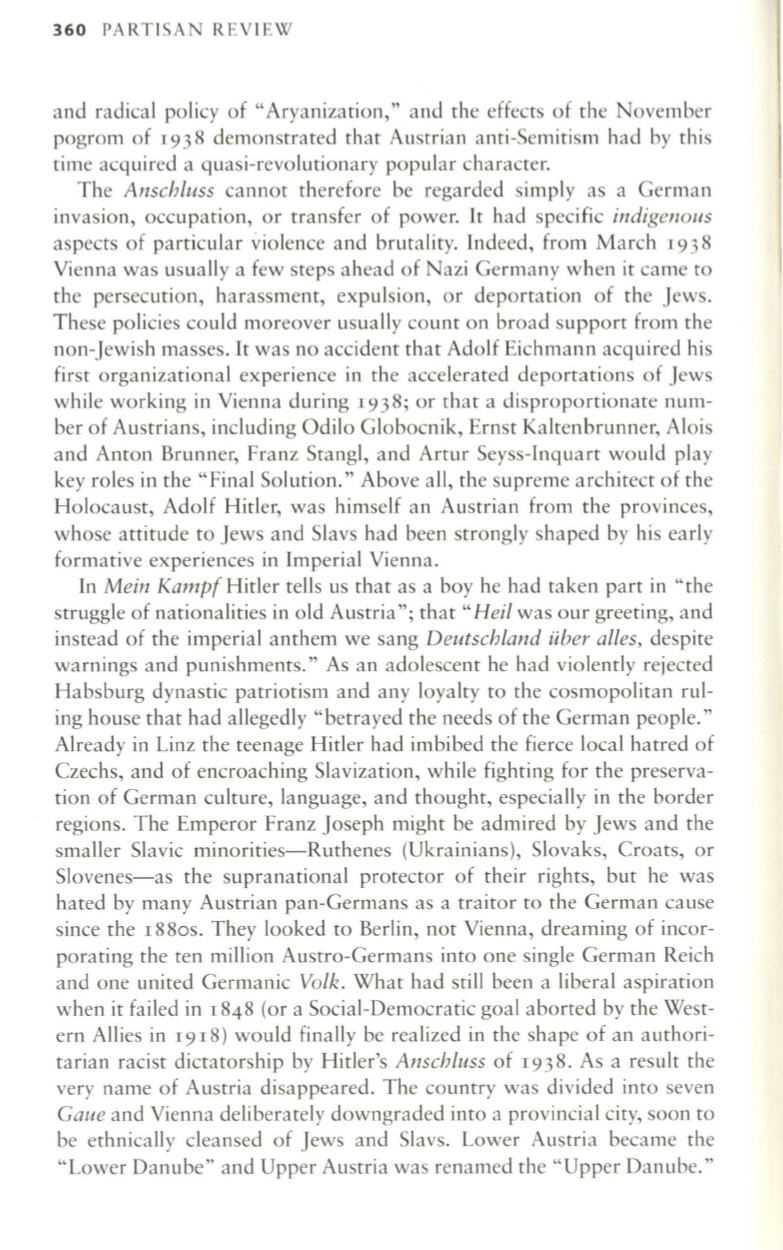
360
PARTISAN REVIEW
and radical policy of "Aryanization," and the effects of the November
pogrom of 1938 demonstrated that Austrian anti-Semitism had by this
time acquired a quasi-revolutionary popular character.
The
Anschluss
cannot therefore be regarded simply as a German
invasion, occupation, or transfer of power.
It
had specific
indigenous
aspects of particular violence and brutality. Indeed, from March 1938
Vienna was usually a few steps ahead of Nazi Germany when it came to
the persecution, harassment, expulsion, or deportation of the Jews.
These policies could moreover usually count on broad support from the
non-Jewish masses.
It
was no accident that Adolf Eichmann acquired his
first organizational experience in the accelerated deportations of Jews
while working in Vienna during 1938; or that a disproportionate num–
ber of Austrians, including Odilo Globocnik, Ernst Kaltenbrunner, Alois
and Anton Brunner, Franz Stangl, and Artur Seyss-Inquart would play
key roles in the "Final Solution." Above all, the supreme architect of the
Holocaust, Adolf Hitler, was himself an Austrian from the provinces,
whose attitude to Jews and Slavs had been strongly shaped by his early
formative experiences in Imperial Vienna.
In
Mein Kampf
Hitler tells us that as a boy he had taken part in "the
struggle of nationalities in old Austria"; that
"Heil
was our greeting, and
instead of the imperial anthem we sang
Deutschland iiber alles,
despite
warnings and punishments." As an adolescent he had violently rejected
Habsburg dynastic patriotism and any loyalty to the cosmopolitan rul–
ing house that had allegedly "betrayed the needs of the German people."
Already in Linz the teenage Hitler had imbibed the fierce local hatred of
Czechs, and of encroaching Siavization, while fighting for the preserva–
tion of German culture, language, and thought, especially in the border
regions. The Emperor Franz Joseph might be admired by Jews and the
smaller Slavic minorities-Ruthenes (Ukrainians), Slovaks, Croats, or
Slovenes-as the supranational protector of their rights, but he was
hated by many Austrian pan-Germans as a traitor to the German cause
since the 1880s. They looked to Berlin, not Vienna, dreaming of incor–
porating the ten million Austro-Germans into one single German Reich
and one united Germanic
Volk.
What had still been a liberal aspiration
when it failed in 1848 (or a Social-Democratic goal aborted by the West–
ern Allies in 1918) would finally be realized in the shape of an authori–
tarian racist dictatorship by Hitler's
Anschluss
of 1938. As a result the
very name of Austria disappeared. The country was divided into seven
Gaue
and Vienna deliberately downgraded into a provincial city, soon to
be ethnically cleansed of Jews and Slavs. Lower Austria became the
"Lower Danube" and Upper Austria was renamed the "Upper Danube."


